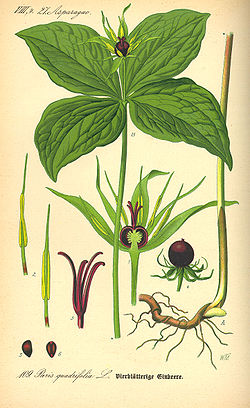Paris quadrifolia
| Paris quadrifolia | |
|---|---|

| |
| Paris quadrifolia in Ciemnik, Poland | |
| Scientific classification | |
| Kingdom: | Plantae |
| Clade: | Tracheophytes |
| Clade: | Angiosperms |
| Clade: | Monocots |
| Order: | Liliales |
| Family: | Melanthiaceae |
| Genus: | Paris |
| Species: | P. quadrifolia
|
| Binomial name | |
| Paris quadrifolia | |
| Synonyms[2] | |
| |


Paris quadrifolia, the herb Paris[4] or true lover's knot, is a species of flowering plant in the family Melanthiaceae. It occurs in temperate and cool areas throughout Eurasia, from Spain to Yakutia, and from Iceland to Mongolia.[2] It prefers calcareous soils and lives in damp and shady places, especially old established woods and stream banks.
P. quadrifolia is in decline in Europe due to loss of habitat.[5] In Iceland, for example, it is on the red list.[6]
Description
[edit]P. quadrifolia is a perennial herbaceous plant that is 25 to 40 cm (10 to 15.5 in) tall. It may have 3–8 leaves but typically there are four leaves arranged as opposing pairs. The flowers are wispy and inconspicuous.[5][7]
The plant flowers during the months of June and July.[8] It has a solitary flower with four narrow greenish filiform (threadlike) petals, four green petaloid sepals, eight golden yellow stamens, and a round purple to red ovary. The flower is borne above a single whorl of four leaves.
Each plant produces at most one blueberry-like berry, which is poisonous, because it contains solanine, as are other plant tissues.[9] Poisonings are rare because the plant's solitary berry has a repulsive taste that makes it difficult to mistake for a bilberry.
Taxonomy
[edit]It was described by Carl Linnaeus in 1753.[10][5]
Etymology
[edit]The specific epithet quadrifolia means four-leaved.[11]
Conservation
[edit]It is categorised as a species of Least Concern (LC) according to the IUCN red list.[1]
Gallery
[edit]-
Herb Paris with Fruit
-
Typical Herb Paris woodland habitat in Ayrshire, Scotland.
-
Fruit
-
Details of the leaves.
-
Typical limestone (cornstone) based woodlands rich in Herb Paris colonies.
References
[edit]- ^ a b Chadburn, H. 2014. Paris quadrifolia (Europe assessment). The IUCN Red List of Threatened Species 2014: e.T203363A2764379. Accessed on 19 May 2025.
- ^ a b "Paris quadrifolia". World Checklist of Selected Plant Families (WCSP). Royal Botanic Gardens, Kew.
- ^ Prof. Dr. Otto Wilhelm Thomé Flora von Deutschland, Österreich und der Schweiz 1885, Gera, Germany
- ^ BSBI List 2007 (xls). Botanical Society of Britain and Ireland. Archived from the original (xls) on 2015-06-26. Retrieved 2014-10-17.
- ^ a b c "Paris quadrifolia". Plants of the World Online. Retrieved 21 October 2019.
- ^ "Red List for Vascular Plants". Icelandic Institute Of Natural History. Retrieved 21 October 2019.
- ^ "Paris quadrifolia". Flora of China. Vol. 24 – via eFloras.org, Missouri Botanical Garden, St. Louis, MO & Harvard University Herbaria, Cambridge, MA.
- ^ Altervista Flora Italiana, Uva di volpe Paris quadrifolia L.
- ^ Jacquemyn, Hans; Brys, Rein; Hutchings, Michael J. (July 2008), "Biological Flora of the British Isles: Paris quadrifolia L.", Journal of Ecology, 96 (4): 833–844, Bibcode:2008JEcol..96..833J, doi:10.1111/j.1365-2745.2008.01397.x
- ^ Linné, Carl von, & Salvius, Lars. (1753). Caroli Linnaei ... Species plantarum :exhibentes plantas rite cognitas, ad genera relatas, cum differentiis specificis, nominibus trivialibus, synonymis selectis, locis natalibus, secundum systema sexuale digestas... (Vol. 1, p. 367). Impensis Laurentii Salvii. https://www.biodiversitylibrary.org/page/358386
- ^ Spektrum der Wissenschaft. (2013, September 16). Paris quadrifolia. Lexikon Der Arzneipflanzen Und Drogen. Retrieved May 19, 2025, from https://www.spektrum.de/lexikon/arzneipflanzen-drogen/paris-quadrifolia/10783
External links
[edit]






